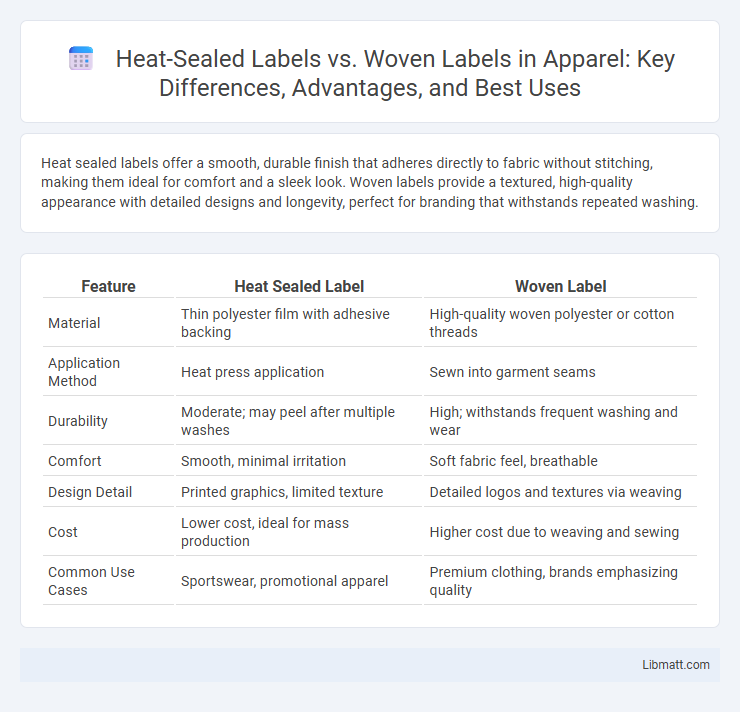Heat sealed labels offer a smooth, durable finish that adheres directly to fabric without stitching, making them ideal for comfort and a sleek look. Woven labels provide a textured, high-quality appearance with detailed designs and longevity, perfect for branding that withstands repeated washing.
Table of Comparison
| Feature | Heat Sealed Label | Woven Label |
|---|---|---|
| Material | Thin polyester film with adhesive backing | High-quality woven polyester or cotton threads |
| Application Method | Heat press application | Sewn into garment seams |
| Durability | Moderate; may peel after multiple washes | High; withstands frequent washing and wear |
| Comfort | Smooth, minimal irritation | Soft fabric feel, breathable |
| Design Detail | Printed graphics, limited texture | Detailed logos and textures via weaving |
| Cost | Lower cost, ideal for mass production | Higher cost due to weaving and sewing |
| Common Use Cases | Sportswear, promotional apparel | Premium clothing, brands emphasizing quality |
Introduction to Heat Sealed and Woven Labels
Heat sealed labels are created by applying a heat-activated adhesive that bonds directly to the fabric, providing a smooth, lightweight, and often waterproof finish ideal for sportswear and swimwear. Woven labels, made from woven threads, offer durability and a premium textured look, commonly used for branding in apparel and accessories. Your choice between heat sealed and woven labels depends on fabric type, garment use, and the desired aesthetic quality.
What is a Heat Sealed Label?
A heat sealed label is a type of garment labeling that uses heat and pressure to bond the label directly onto the fabric without stitching, creating a smooth, flat finish ideal for comfort and durability. This labeling method ensures your designs remain vibrant and intact through multiple washes, making it popular in activewear and children's clothing. Unlike woven labels, heat sealed labels do not add bulk or irritation, offering a sleek solution for branding and care instructions.
What is a Woven Label?
A woven label is a fabric tag created by weaving threads together to form detailed designs and text, commonly used for branding and care instructions on clothing. It offers durability, a high-quality appearance, and resistance to fading and fraying compared to printed labels. Woven labels are favored in fashion and textile industries for their ability to maintain clarity and texture after multiple washes.
Key Differences Between Heat Sealed and Woven Labels
Heat sealed labels adhere directly to fabric through heat and pressure, offering a smooth, flexible feel ideal for sportswear and seamless designs. Woven labels consist of woven threads creating detailed, durable designs with a traditional fabric texture, commonly used for brand logos and care instructions. Understanding these key differences helps ensure your clothing labels match your product's functionality and aesthetic requirements.
Advantages of Heat Sealed Labels
Heat sealed labels offer superior durability and resistance to washing and wear, making them ideal for activewear and uniforms. Their smooth surface enhances comfort, eliminating irritation often caused by woven labels. You benefit from a sleek and professional appearance that maintains clarity and color after multiple washes.
Advantages of Woven Labels
Woven labels offer exceptional durability and a high-quality appearance, making them ideal for garments that undergo frequent washing or heavy use. They provide intricate detailing and vibrant colors through tightly interlaced threads, ensuring longevity without fading or peeling. Your branding benefits from the premium texture and professional look woven labels provide, enhancing the overall value of your products.
Best Uses for Heat Sealed Labels
Heat sealed labels are ideal for clothing items requiring a smooth, tagless finish, such as activewear, underwear, and baby garments, where comfort and irritation-free wear are priorities. These labels bond directly to fabric using heat, ensuring durability without added bulk or scratchiness, making them perfect for performance textiles and swimwear. Their seamless integration also suits minimalist fashion designs and branding that demands subtle, low-profile labeling.
Best Uses for Woven Labels
Woven labels are ideal for high-end apparel, providing durability and a premium appearance that withstands frequent washing and wear. Their intricate weaving process allows for detailed designs, making them perfect for brand logos and care instructions on garments such as denim, outerwear, and sportswear. Woven labels offer long-lasting quality and a refined texture that enhances the overall garment presentation.
Factors to Consider When Choosing Label Types
Heat sealed labels offer a smooth, flat finish ideal for delicate fabrics, while woven labels provide durability and a textured, high-quality appearance suitable for heavy-duty garments. Consider the garment's material, washing frequency, and desired longevity when choosing between heat sealed and woven labels to ensure the label withstands wear and maintains clarity. Your choice impacts both comfort and brand presentation, making it essential to evaluate label flexibility, placement, and production cost.
Conclusion: Which Label is Right for You?
Choosing between a heat sealed label and a woven label depends on your product's durability needs and aesthetic preferences. Heat sealed labels offer a smooth finish ideal for minimal irritation and are great for lightweight fabrics, while woven labels provide superior durability and a premium look suitable for high-end apparel. Consider Your brand identity, fabric type, and longevity requirements to select the label that best enhances Your product's quality and user experience.
Heat Sealed Label vs Woven Label Infographic

 libmatt.com
libmatt.com